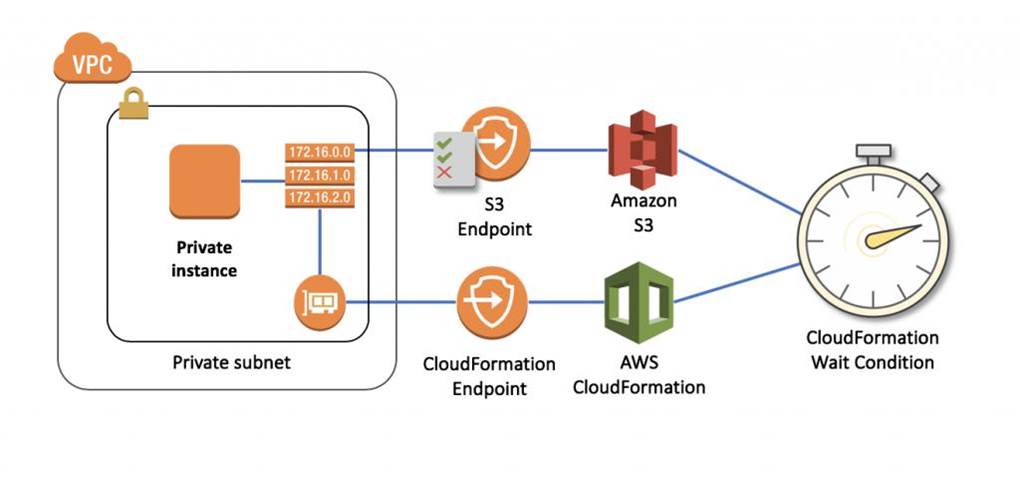Which of the following should the Architect do to meet this requirement?
A company is deploying a Microsoft SharePoint Server environment on AWS using CloudFormation. The Solutions Architect needs to install and configure the architecture that is composed of Microsoft Active Directory (AD) domain controllers, Microsoft SQL Server 2012, multiple Amazon EC2 instances to host the Microsoft SharePoint Server and many other dependencies. The Architect needs to ensure that the required components are properly running before the stack creation proceeds .
Which of the following should the Architect do to meet this requirement?
A . Configure a CreationPolicy attribute to the instance in the CloudFormation template. Send a success signal after the applications are installed and configured using the cfn-signal helper script.
B . Configure the UpdateReplacePolicy attribute in the CloudFormation template. Send a success signal after the applications are installed and configured using the cfn-signal helper script.
C . Configure the DependsOn attribute in the CloudFormation template. Send a success signal after the applications are installed and configured using the cfn-init helper script.
D . Configure a UpdatePolicy attribute to the instance in the CloudFormation template. Send a success
signal after the applications are installed and configured using the cfn-signal helper script.
Answer: A
Explanation:
You can associate the CreationPolicy attribute with a resource to prevent its status from reaching create complete until AWS CloudFormation receives a specified number of success signals or the timeout period is exceeded. To signal a resource, you can use the cfn-signal helper script or SignalResource API. AWS CloudFormation publishes valid signals to the stack events so that you track the number of signals sent.
The creation policy is invoked only when AWS CloudFormation creates the associated resource. Currently, the only AWS CloudFormation resources that support creation policies are AWS::AutoScaling::AutoScalingGroup, AWS::EC2::Instance, and AWS::CloudFormation::WaitCondition.

Use the CreationPolicy attribute when you want to wait on resource configuration actions before stack creation proceeds. For example, if you install and configure software applications on an EC2 instance, you might want those applications to be running before proceeding. In such cases, you can add a CreationPolicy attribute to the instance, and then send a success signal to the instance after the applications are installed and configured.
Hence, the option that says: Configure a CreationPolicy attribute to the instance in the CloudFormation template. Send a success signal after the applications are installed and configured using the cfn-signal helper script is correct.
The option that says: Configure the DependsOn attribute in the CloudFormation template. Send a success signal after the applications are installed and configured using the cfn-init helper script is incorrect because the cfn-init helper script is not suitable to be used to signal another resource. You have to use cfn-signal instead. And although you can use the DependsOn attribute to ensure the creation of a specific resource follows another, it is still better to use the CreationPolicy attribute instead as it ensures that the applications are properly running before the stack creation proceeds.
The option that says: Configure a UpdatePolicy attribute to the instance in the CloudFormation template. Send a success signal after the applications are installed and configured using the cfn-signal helper script is incorrect because the UpdatePolicy attribute is primarily used for updating resources and for stack update rollback operations.
The option that says: Configure the UpdateReplacePolicy attribute in the CloudFormation template.
Send a success signal after the applications are installed and configured using the cfn-signal helper
script is incorrect because the UpdateReplacePolicy attribute is primarily used to retain or in some
cases, back up the existing physical instance of a resource when it is replaced during a stack update
operation.
References:
https://docs.aws.amazon.com/AWSCloudFormation/latest/UserGuide/aws-attribute-creationpolicy.html
https://docs.aws.amazon.com/AWSCloudFormation/latest/UserGuide/deploying.applications.html#deploy
ment-walkthrough-cfn-signal
https://aws.amazon.com/blogs/devops/use-a-creationpolicy-to-wait-for-on-instance-configurations/
Check out this AWS CloudFormation Cheat Sheet:
https://tutorialsdojo.com/aws-cloudformation/
AWS CloudFormation – Templates, Stacks, Change Sets:
https://www.youtube.com/watch?v=9Xpuprxg7aY
Latest SAA-C03 Dumps Valid Version with 400 Q&As
Latest And Valid Q&A | Instant Download | Once Fail, Full Refund

